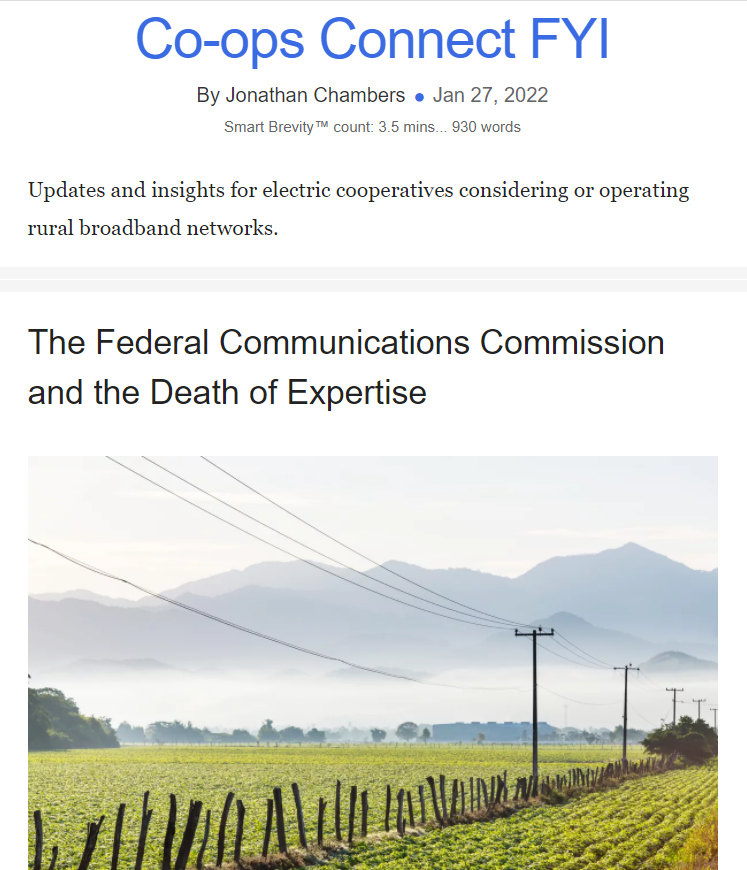The Federal Communications Commission and the Death of Expertise
January 27, 2022
Remember last week’s takeaway:
NTIA and states should provide explicit and binding guidance about “unserved” areas eligible for Infrastructure Act funding to speed the deployment of rural broadband.
Updates and insights for electric cooperatives considering or operating rural broadband networks.
The Communications Act gives the FCC the authority and the task of ensuring universal access to broadband.
- In 1996, Congress charged the FCC with preserving and advancing the universal availability of telecommunications and information services to low-income consumers and those living in rural and high-cost areas.
- Service in rural, high-cost areas must be “reasonably comparable” to service available in urban areas.
- Over the past 25 years, the FCC collected, spent, and committed over $200 billion for its many universal service programs.
Though $100 billion has been spent on rural broadband, there are as many unserved households today as there have ever been.
And so:
- In 2021, Congress appropriated $42.5 billion in funding to states and NTIA, rather than the FCC, for rural broadband programs.
- Why it matters: This decision is partly a rebuke of the FCC for the failures of its past two Chairmen (one Republican, one Democrat) to meet the needs of rural America.
A smarter approach for the future
Big picture: NTIA and state broadband offices, with limited FCC involvement, are now responsible for spending the public’s money on rural broadband.
A smart approach would make use of the expertise developed by the FCC.
Four categories where the FCC can help:
1. Mapping
2. Cost models
3. Competitive bidding mechanisms
4. Program administration
Mapping: The National Broadband Map
In 2009, Congress funded the creation of a National Broadband Map, dividing the work of delivering it between NTIA and the FCC.
- NTIA administered a program, the State Broadband Initiative or SBI, and worked with states to collect broadband data.
- The data was wildly inconsistent and of poor quality.
- When SBI funding ended, NTIA handed off all data collection to the FCC.
- The FCC created and maintained the National Broadband Map for over a decade.
The current map is widely criticized for relying on unverified, self-reported ISP data. Despite its flaws, the FCC’s data is still the only national, consistent collection of broadband availability.
In 2020, Congress appropriated funding to the FCC to create a new map.
- The FCC is attempting a novel approach, using a granular “location fabric” which likely will not be public until 2023.
- Yes, but: The FCC is still relying on unverified, self-reported ISP data.
The bottom line:
- The Infrastructure Act requires maps – maps of unserved areas and of high-cost areas.
- The FCC is repeating its mistakes by using proprietary data and relying on self-reporting by internet service providers.
Is there a better way? Yes, by opening up and speeding up the process.
Cost Models: The Connect America Cost Model
To calculate the cost of building, maintaining and operating a broadband network, the FCC modeled a greenfield fiber-to-the-premise Gigabit Passive Optical Network.
- The project calculated the cost of a fiber network built to every rural home and small business.
- The FCC chose fiber over copper, hybrid fiber coax, fixed and mobile wireless, and satellite networks.
- Why? A fiber network is the best long-term investment of public or private money to meet the needs of consumers today and for decades to come.
- As Paul De Sa, my predecessor and successor at the FCC, has put it:
“Why would one not pick fiber every time? Why do you have to be ‘technology neutral’ when there are clear differences between the performance and the incremental upgrade costs of the technologies?”
The bottom line: State broadband offices should have access to an objective cost model for budgeting and program administration.
The Infrastructure Act requires a method for determining high-cost areas.
The FCC’s Connect America cost model is still one of the best tools available, but it has never been made public.
Competitive Bidding Mechanisms
The FCC’s broadband reverse auctions were groundbreaking government policy.
- Yes, but: Amateurish execution despoiled the otherwise novel, extraordinary FCC auction staff work.
- Two FCC Chairmen made catastrophic decisions in both auction design and implementation.
Vetting bidders before an auction is more important than vetting bidders after an auction.
The bottom line:
- States need competitive bidding mechanisms. An auction can be a highly efficient tool.
- While a future RDOF auction is unlikely, the auction software could be of great use to state programs.
Program Administration
The Infrastructure Act will require an unprecedented level of program administration by state broadband offices. The Universal Service Administrative Company (USAC) has successfully processed hundreds of billions in funding since its inception:
State broadband offices will be overwhelmed with funding requests.
The American Rescue Plan Act programs already receive requests that are ten times the size of the broadband budgets.Most state broadband offices are staffed with just a handful of people.
Errors and delays are likely.
The bottom line:
The administrative tools developed by the FCC and USAC should be made available to states.
Tip: To avoid being overwhelmed with funding requests, programs should only accept applications for funding on an annual basis.
What can an applicant complete in 2022? Those that are successful can apply for funding in 2023. And so on.
Final Thought
NTIA is charged with most of the Infrastructure Act implementation.
It should focus on tools usable by states and other federal agencies.
Open, public systems for broadband mapping, high-cost modeling, and competitive bidding are needed.

